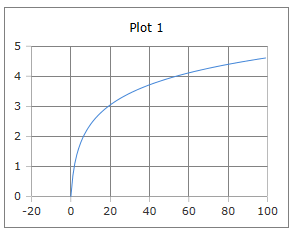Ln, natural logarithm to base e
Calculator and formula for the natural logarithm to base e
Natural logarithm calculator
What is calculated?
The Ln function returns the natural logarithm to base e of the given number (power value). The argument must be a positive real number.
Function graph

Graph of the natural logarithm function ln(x)
Natural logarithm info
Properties
Natural logarithm:
- Base: e ≈ 2.71828
- Domain: (0, ∞)
- Range: (-∞, ∞)
- Inverse function of e^x
Note: The natural logarithm is defined only for positive numbers. For complex numbers a separate function is available.
Special values
Logarithm of 1 is always 0
Logarithm of the base is 1
Logarithm of e² is 2
Negative logarithm
Related functions
For complex numbers a separate Ln function is available: → Complex logarithm
Formulas of the natural logarithm
Definition
Conversion
Product rule
Power rule
Quotient rule
Derivative
Calculation example
Example: calculate ln(20)
Given:
- x = 20
- Wanted: ln(20)
Calculation:
Interpretation: 2.996 is the exponent to which the base e must be raised to obtain 20.
Practical example
Exponential growth
Problem:
A bacterial culture grows exponentially. After what time will the population double if the growth rate r = 0.693 per hour?
Solution:
Definition and properties
Euler's number e
The base of the natural logarithm is Euler's number e ≈ 2.71828. It is one of the most important mathematical constants and appears in many natural growth processes.
Applications
The natural logarithm is used in many fields: compound interest, exponential growth and decay, information theory, statistics and probability.
Important properties
- Domain: x > 0
- Range: all real numbers
- Monotonicity: strictly increasing
- Continuity: continuous on (0, ∞)
|
|